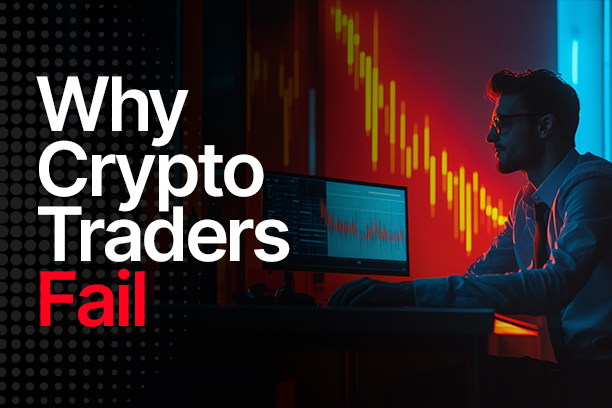The crypto market is not a level playing field, it’s a battlefield where institutional investors hold the upper hand.
On the episode of The CoinRock Show, Matthias dives into one of the most overlooked yet critical aspects of the crypto market—institutional influence and manipulation.
Matthias believed the crypto market isn’t a fair game rather a battlefield where institutional investors have the advantage. While retail traders chase price action and react emotionally to market swings, big players are strategically engineering price movements to maximize their gains.
During the episode, Matthias explains how institutions use advanced trading strategies, liquidity manipulation, and psychological tactics to shape market sentiment.
These strategies—ranging from spoofing and stop-loss hunting to media influence and FOMO cycles—are often invisible to the average investor, leaving many retail traders wondering why they always seem to buy at the top and sell at the bottom.

Hidden Forces Behind Crypto Price Movements
Retail traders often believe that Bitcoin and altcoin price movements are random, driven by natural supply and demand. The reality is far more complex. Institutional players—hedge funds, high-frequency trading firms, and market makers—control significant trading volume.
This means they have the power to create artificial market conditions that trigger emotional reactions from inexperienced traders.
Matthias explains: “Retail traders react to price moves; institutions create them. Every major pump or dump is part of a bigger strategy—one designed to shake out weak hands.”
By understanding how institutions operate, you can see market moves for what they are—not organic trends but engineered events designed to transfer wealth from impatient traders to smart money.
Liquidity Games: How Institutions Trap Retail Traders
One of the institutions’ most common tactics to manipulate the crypto market is controlling liquidity zones—specific areas where many buy or sell orders are concentrated. Institutions can trigger forced liquidations by targeting these zones, shake out retail traders, and accumulate assets at lower prices.
A primary method of liquidity manipulation is stop-loss hunting, where institutions deliberately push the price down (or up) to trigger stop-loss orders set by retail traders.
Since most retail investors set stop-losses at predictable levels, big players take advantage of this by engineering sudden price drops that cause a cascade of liquidations.
For example, if Bitcoin trades at $75,000, many retail traders might have stop-losses placed around $74,500. Institutions push the price down slightly further to $74,400, triggering a wave of automated sell-offs. As retail traders panic and sell at a loss, the price suddenly bounces back, allowing institutions to buy in at lower prices while weak hands exit the market.
Matthias explains: “If you’re constantly getting stopped out of your trades, it’s not bad luck—it’s by design. The market is structured to liquidate weak hands before making its real move.”
Another widely used manipulation tactic is spoofing, where institutions place fake buy or sell orders without intending to execute them.
This technique creates a false impression of market demand or supply, influencing retail traders to make emotional decisions.
A hedge fund, for instance, might place a massive sell order to create fear, causing retail traders to panic and start selling their holdings. Just before the order executes, the hedge fund cancels it at the last second and buys Bitcoin at the newly discounted price.
This deceptive strategy allows institutions to accumulate assets at a lower cost while misleading retail traders into selling prematurely.
Although spoofing is illegal in traditional financial markets, it frequently occurs in crypto, especially in low-liquidity altcoins.
Many retail traders remain unaware that these seemingly natural market movements are engineered strategies designed to shake them out before institutions execute their actual trades.

Media Manipulation Controlling the Narrative
Institutions don’t just manipulate price action—they also manipulate public sentiment, shaping how retail traders perceive the market.
Many individual investors make decisions based on news headlines, Twitter posts, and influencer opinions, unaware that large investors often strategically place these narratives to serve their interests.
Through media control and social influence, institutions create artificial cycles of fear and euphoria, leading retail traders to buy or sell at precisely the wrong moments.
One of the most common sentiment manipulation tactics is the Fear & FOMO Cycle.
Institutional investors use mainstream media to spread Fear, Uncertainty, and Doubt (FUD) at key moments when they want to buy lower-priced assets.
For example, before accumulating Bitcoin, they might push bearish headlines about government crackdowns, exchange failures, or economic uncertainty. As a result, retail traders panic-sell, allowing institutions to accumulate Bitcoin at a discount.
Once they have secured their positions, the narrative suddenly shifts to bullish news—headlines like “Bitcoin ETFs are booming” or “Institutions are buying Bitcoin” flood the market. This fuels FOMO (Fear of Missing Out), driving retail traders to buy at inflated prices, just as institutions begin taking profits.
Matthias warns: “If the news is telling you to buy, you’re already too late. If the news is telling you to sell, it’s probably time to buy.”
Beyond mainstream media, institutions also leverage social media platforms like Twitter, Telegram, and YouTube to manipulate sentiment through paid narratives. Many influencers and analysts who promote certain coins, projects, or exaggerated price predictions are often compensated to do so.
Institutions capitalize on this by creating artificial hype around specific assets, causing unsuspecting retail traders to buy into manipulated price movements.
Some key signs of institutional influence in social media narratives include overhyped price predictions like “Bitcoin to $250K by next month!”, vague claims about mysterious whale activity with no verifiable sources, and fake partnership announcements to pump a project’s price before a massive institutional sell-off.
Retail traders who fall for these tactics often buy at market peaks, while institutions are already cashing out their profits. By understanding these psychological manipulation techniques, investors can avoid being trapped by institutional narratives and position themselves for more brilliant, strategic trades.
How to Profit from Institutional Strategies
Instead of falling victim to institutional market manipulation, savvy traders can use these strategies by focusing on accurate data rather than emotional reactions. One of the most effective ways to do this is following on-chain analytics rather than relying on news headlines.
Institutional investors leave digital footprints, and tracking whale wallet activity, Bitcoin ETF inflows, and exchange reserves can provide key insights into their movements. Large BTC transfers often signal accumulation or selling, while rising inflows into Bitcoin ETFs indicate institutional buying.
Additionally, a decrease in BTC reserves on exchanges suggests that investors are moving their holdings to cold storage for long-term holding. By following accurate on-chain data, traders can anticipate market moves before they happen instead of reacting to manipulated narratives.
Another way to outsmart institutional traps is by identifying liquidity manipulation before it occurs. Stop-loss hunting and forced liquidations are common strategies institutions use to shake out weak hands. To avoid these traps, traders should avoid placing stop-losses at noticeable price levels, such as round numbers like $75,000 or $80,000.
These levels are prime targets for institutional price manipulation. Additionally, watching for fake breakouts and sudden reversals can help traders recognize when an institutional trap is in play, allowing them to adjust their positions accordingly.
Most importantly, thinking like an institution rather than a retail trader is the key to long-term success in crypto. Traders should position themselves strategically for long-term gains rather than chasing short-term moves fueled by hype. The best opportunities come during market fear, not during euphoria.
Savvy investors accumulate Bitcoin and Ethereum when negative news dominates the market, rather than buying in when hype is at its peak. Ignoring short-term price swings and focusing on macro trends allows traders to stay ahead of the curve.
The golden rule? Buy when the market is silent and sell when everyone is euphoric. Institutions follow this strategy, and smart retail traders should do the same.
Outsmart the Market Makers
The crypto market is rigged in favor of institutional investors, but that doesn’t mean retail traders can’t win. By understanding how big players manipulate price action, create artificial narratives, and control liquidity, you can position yourself ahead of the game.
Most retail traders lose money because they fall for these traps. But those who recognize the patterns, follow smart money instead of headlines, and trade against the crowd will walk away with real profits.
The real question is: Will you continue playing by their rules or start beating them at their own game?





